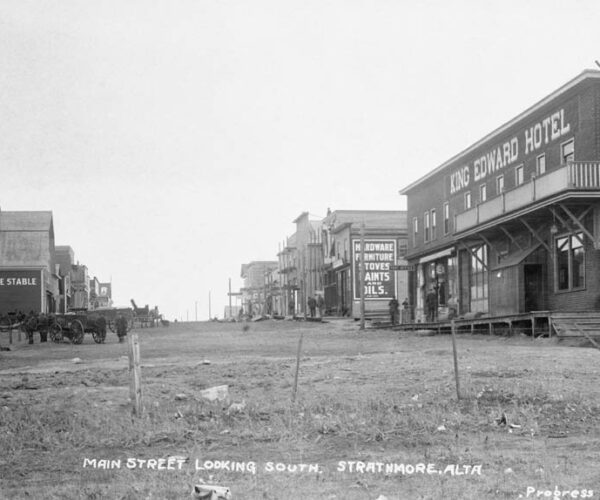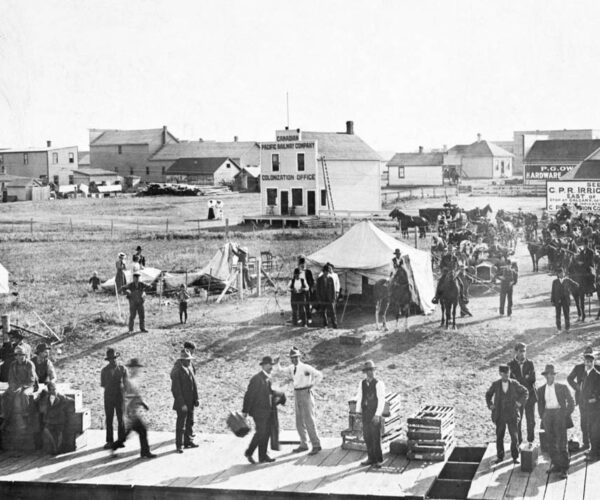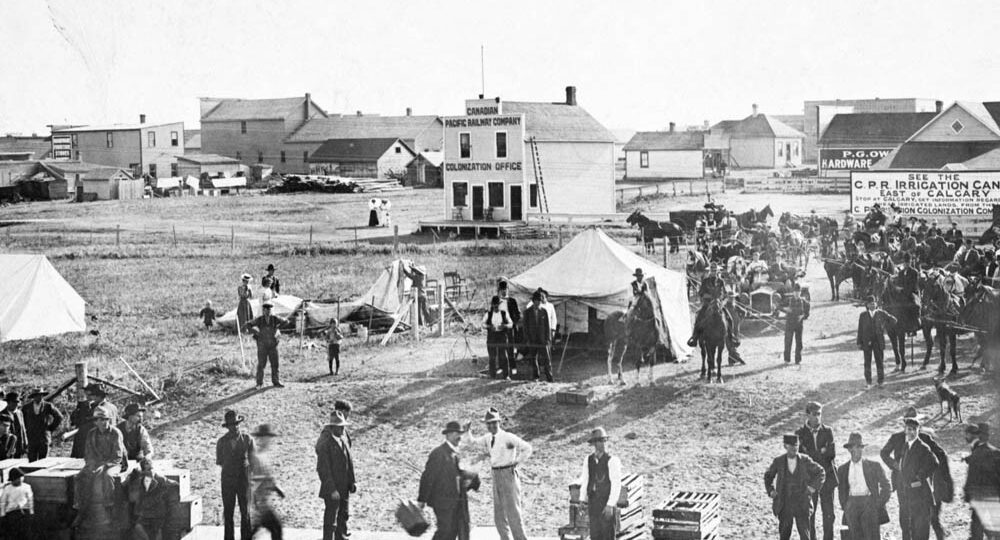
Father van Aken’s Dutch Settlement in Canada
It’s December 1908 in Strathmore, a town in southern Alberta, about 50 km east of Calgary, in western Canada. Dutch settlers in the newly founded settlement of Akenstad are desperate.
Most of their crops were lost in a hailstorm. Some were even facing bankruptcy. It’s a stark contrast with the situation just a little over half a year prior, during Easter. Father Van Aken, at first celebrated to the point of having the settlement after him, received most of the blame. Was this blame justified? What was the role of Van Aken within the community, and what caused the settlers to turn on him?
Between 1880 and 1940, there was an increase in the number of people emigrating from the Netherlands to Canada. According to historian Henk van Stekelenburg, this was due to the modernization of the workforce. Employment on farms in the Dutch region of North-Brabant was low, caused in part by the expansion of the industrial and service sectors. As a result, the prospect of emigrating to a nation like Canada, which was in need of their skills, seemed appealing to young Dutch farmers. Ironically, thanks to the fruits of the Industrial Revolution, emigration to Canada was much easier than ever before. The invention of the steamboat and the expansion of the railroads meant that emigrants could reach Strathmore within a few weeks, while the invention of the telegraph meant that they could keep in touch with their loved ones at home. The group that Van Aken led was one of many others that were persuaded by these conditions.
Cornelius Marinus Henricus van Aken was born in 1872 in West-Brabant. From a young age, he became engrossed in theology, which set him on the path to eventually becoming a Father in 1896. Like many other Europeans at that time, he was drawn to the North American continent and aspired to create a settlement there. After several failed attempts to find a place where he could settle, he was contacted by someone from the Canadian Pacific Railway (CPR), which had been instructed by the Canadian government to help recruit new colonists to the country. There was still an ample amount of cheap land available. Van Aken was tasked with convincing his peers in Brabant to emigrate to these lands.
On the surface, this was not a bad idea. Van Aken knew that many of the young farmers in Brabant were desperate for opportunity, something they could have in Canada. With that in mind, he began organizing transatlantic crossings. The first group of Dutch emigrants he traveled with to Canada set sail on March 12, 1908. One of the over thirty people part of the journey sent letters chronicling their trip to the Dutch newspaper De Tilburgsche Courant. Thanks to his account, we know a little more about their perilous voyage. Departing from Rotterdam, they travelled to Hull City before continuing to Liverpool. From there, they embarked for Canada. Van Aken is portrayed as being involved and caring. In Liverpool, he gave the group a brief tour of the town, while on the ship, he ensured that people traveling together had their accommodation sorted.
Upon arriving in Canada, the settlers were greeted with cold and snowy weather. To reach their destination near Calgary, the Dutch colonists had to traverse the wintry Canadian landscape by train for another four to five days, and they were far from pleased to find out that their seating arrangements were very uncomfortable. Taking the matter into his own hands, Van Aken argued with the train’s conductor. When that yielded no results, he sent a telegraph to the railroad company’s headquarters, threatening that if the situation did not improve, they would all go home. His actions proved effective. The next morning, all settlers received a mattress and a blanket to make the journey at least bearable.
Finally, on 27 March 1908, the group reached Calgary. After a quick tour around town, they were brought to the edges of a new settlement named Strathmore, east of Calgary. Here, they would all select an area for farming and create a new district. Even though Van Aken’s responsibilities were over by then, he nonetheless surprised his Dutch newcomers by buying them tickets for the local theater. A couple of days later in April, when everyone had chosen their land, there was a meeting involving the entire group of Dutch settlers, which Van Aken also attended. During the meeting, they first decided to name their settlement ‘Henriette’, after the mother of Van Aken; they had to change this, however, because there was already a town with the same name. Still intending to honor the man who brought them together in this place, they renamed the town to ‘Akenstad’. After giving the Easter mass, Van Aken went back to the Netherlands, with the aim of bringing more farmers to the region.

Around the end of the year, there was a massive hailstorm that ruined the crops of many farmers in the area, and the buzz surrounding Van Aken started to become negative. Anton Weijers, one of the Dutch farmers, sent a letter to a Dutch newspaper slamming Van Aken for making false promises and not being around to protect and support his colonists. Many others in the settlement appeared to support Weijers’ sentiment.
Van Aken responded to the accusations made by Weijers, claiming that the blame lay solely with the Dutch farmers, as he had warned them when they first arrived, detailing exactly when to harvest. According to Van Aken, the farmers waited too long and ran the risk of the increasingly bad weather ruining their crops. Thanks to other settlers’ written accounts, we know that Van Aken did inform the colonists of the potential weather risks. The accusation that Van Aken cared about money more than his colonists might have been too harsh: although he did receive bonuses for convincing Dutch farmers to settle around Calgary, his actions suggest a genuine interest in their well-being. Regarding his promises of plenty and opportunity that soon turned into a harsh reality for the settlers, historian Henk van Stekelenburg writes that Van Aken himself was duped by the CPR, which thought it could do more to support the creation of a large Dutch settlement. Van Aken, therefore, might have been just as naïve as the settlers he recruited.
In 1910, Van Aken stopped acting as an agent for the CPR. According to a recent documentary about Dutch emigration, Van Aken settled in New York, left the church and never returned to Strathmore.
In New York, Van Aken lived a very interesting life, worthy of a separate article. It appears that he changed his name from Cornelius to Neil. According to his obituary in the North Adams Transcript, he fought in the First World War, became the Secretary of the Netherlands Chamber of Commerce in New York and he became the President of the Foreign Governments’ Club at the New York World’s Fair. The settlers of the district of Akenstad had varying fates. Some downtrodden farmers chose to go back home; others were more successful working on an irrigation system for the CPR. Akenstad no longer exists today, but Strathmore itself does. It never developed into the large settlement that many settlers envisioned; instead, it remains a small town to this day.
Sources:
Resources at RIAS:
- Henk van Stekelenburg Collection, Box 10, Map 59.
- Stallinga-Ganzevoort Online Collection
Additional sources consulted:
- NTR, “Landverhuizers – 3”, 2025, 44 min., 59 sec., https://anderetijden.nl/programma/25/Landverhuizers/aflevering/1067/Landverhuizers—3
Secondary Sources:
- Stekelenburg, Henk van., Hier is alles vooruitgang, Tilburg 2006
- “Remembering our roots ~ Raymond & Diane Van Bavel,” Strathmore Times, accessed September 11, 2025, https://strathmoretimes.com/2014/remembering-our-roots-raymond-diane-van-bavel/.
- The North Adams Transcript, December 5, 1950
- The Daily Oklahoman, June 4, 1917
Images:
- Prairie Towns, strathmore-24.jpg,
https://prairie-towns.com/strathmore-24.html - Prairie Towns, strathmore-7.jpg,
https://prairie-towns.com/strathmore-7.html



